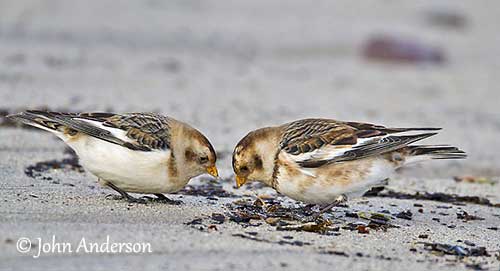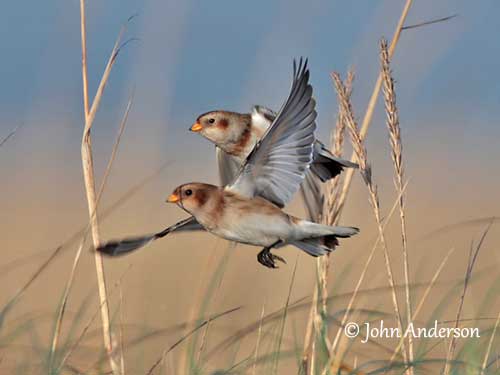Fr: Bruant des neiges - Plectrophane des neiges
Ang: Snow Bunting
All: Schneeammer
Esp: Escribano Nival
Ita: Zigolo delle nevi
Nd: Sneeuwgors
Sd: Snösparv
Photographers:
John Anderson
John Anderson Photo Galleries
Didier Buysse
Vision d’Oiseaux
Jean Michel Fenerole
Photos d’Oiseaux du monde
Tom Grey
Tom Grey's Bird Pictures & Tom Grey's Bird Pictures 2
René Lortie
René Lortie photographe & Galeries d'oiseaux sur Pbase
Otto Plantema
Trips around the world
William Price
PBase-tereksandpiper & Flickr William Price
Ingo Waschkies
My bird pictures on Pbase
Text by Nicole Bouglouan
Sources:
HANDBOOK OF THE BIRDS OF THE WORLD Vol 16 by Josep del Hoyo- Andrew Elliot-David Christie – Lynx Edicions – ISBN: 9788496553781
THE HANDBOOK OF BIRD IDENTIFICATION FOR EUROPE AND THE WESTERN PALEARCTIC by Mark Beaman, Steve Madge - C. Helm - ISBN: 0713639601
L’ENCYCLOPEDIE MONDIALE DES OISEAUX - Dr Christopher M. Perrins - BORDAS - ISBN: 2040185607
ENCYCLOPEDIE DES OISEAUX DE FRANCE ET D’EUROPE – de Peter Hayman et Rob Hume - Flammarion – ISBN : 2082009920
All About Birds (Cornell Lab of Ornithology)
Animal Diversity Web (University of Michigan Museum of Zoology)
Bird Web (Seattle Audubon Society)
What Bird-The ultimate Bird Guide (Mitchell Waite)
Wikipedia, the free encyclopaedia
Snow Bunting
Plectrophenax nivalis
Passeriformes Order – Calcariidae Family
INTRODUCTION:
The Snow Bunting is a bird of open fields and tundra that breeds in the high Arctic, further north than almost any other songbird. It is migratory and spends the winter on coastal areas including beaches, sand dunes and saltmarshes, but also in steppes and farmland.
This species suffers from very low temperatures and digs deep into the snow to stay warm. It is a ground feeder that feeds primarily on seeds, buds and insects. However, during the winter along coasts, it also takes small crustaceans.
The Snow Bunting is a gregarious species that migrates in large flocks in which there is a definite hierarchy. But during the breeding season, the territory is strongly defended.
This species is common within its large circumpolar range, and despite some decline, it is still widespread and not globally threatened.
DESCRIPTION OF THE BIRD:
Biometrics:
Length: 14-18 cm
Weight: 30-45 gr
The Snow Bunting adult male of nominate race in breeding plumage has white head, neck and upperparts. There are sometimes some black areas on the crown. The upperparts are black, with sometimes brown mottling. The rump is white with central black mottling, and the shorter uppertail-coverts are white. On the uppertail, the central rectrices are black with white edges, and the outer rectrices are white with thin black tip on the outer web.
The upperwing is white, except the black alula, primaries (with white bases) and tertials.
The short, pointed bill is black. The eyes are dark brown. Legs and feet are greyish-black.
The non-breeding male has rusty-brown tinge on the white areas, especially on nape, crown, ear-coverts and breast. On the back, the black feathers are edged with brown.
The bill is yellow with reduced black tip.
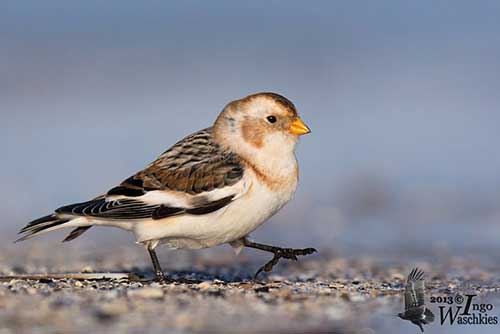
The Snow Bunting adult female is smaller. In breeding plumage, crown, nape and hindneck are darker than in male. The upperparts are mostly brownish, with the darker feathers fringed with pale buff. The white areas of the upperwing are less extensive.
She resembles male when she has very worn plumage. In non-breeding plumage, she is similar to the male.
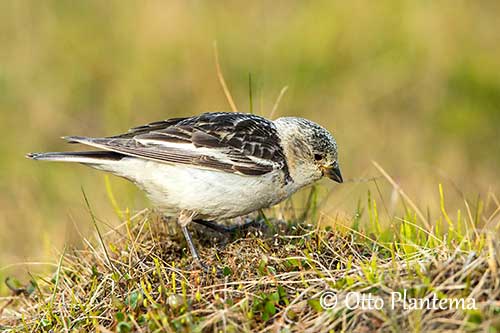
The juvenile has greyish-brown head and breast, often with paler throat. The upperparts are olive-grey with back streaked dark grey. Mantle and scapulars are brownish-grey with blackish streaks on mantle. The underparts are whitish, washed pink to greyish-buff. The bill is yellowish.
The first winter male and female are like adults but duller, and with browner underparts in the young female.
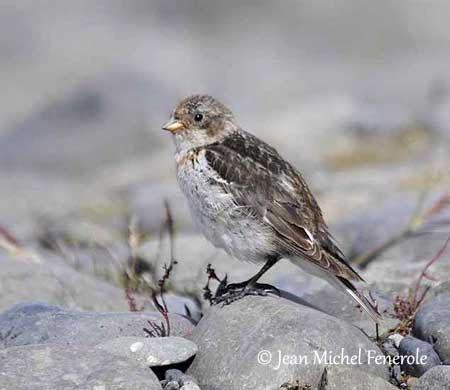
SUBSPECIES AND RANGE:
The Snow Bunting has 4 subspecies that differ mainly in coloration of feather fringes in fresh plumage, extent of black areas and size.
P.n. nivalis breeds in N America, from St Lawrence Island and Alaskan Coast, E across N Canada to coasts of Greenland and N Scotland, Svalbard, W and N Fennoscandia, E to Kola Peninsula.
The non-breeding range extends from SW Alaska and S Canada, S into USA to NW California, Utah, N New Mexico, Kansas, Ohio and Virginia. It also occurs in British Islands and N France, E to S Scandinavia, Germany, Poland and S European Russia, sometimes farther E to Asia Minor.
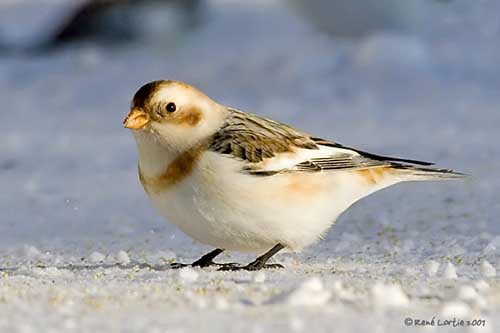
P.n. insulae breeds in Iceland and possibly in N Scotland. They occur in Faeroe Islands and Shetland Islands during the non-breeding season.
P.n. vlasowae breeds in NE European Russia, E through Siberia to Bering Strait, and S to N Shelekhova Gulf and E Kamchatka.
During the non-breeding season, it occurs in C and E Asia S to N Caspian region, Altai, Mongolia, Transbaikalia, NE China, Sakhalin Island, Kuril Island, and sometimes to N Japan and Korea.
P.n. townsendi can be found on Commander Islands, Pribilof and Aleutian Islands.
HABITAT:
The Snow Bunting breeds on open rocky tundra, but also on sea cliffs and occasionally human settlements. It prefers areas with rocky outcrops and boulder fields, and usually avoids the wet tundra.
During winter, it can be seen in open lowland country, from stubble fields, short grass prairies, farmland and steppes to grassy sand dunes, beaches and lake shores.
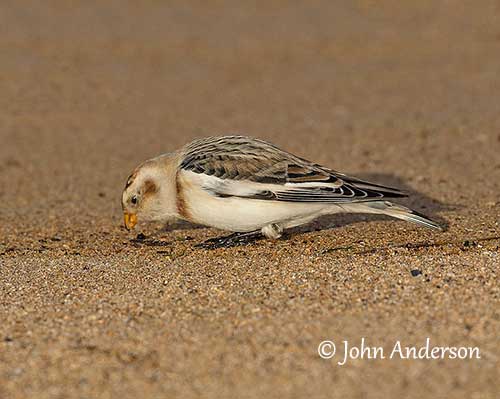
CALLS AND SONGS: SOUNDS BY XENO-CANTO
The Snow Bunting calls when mating in order to attract a female. The call is a soft, undulating twittering “pirrr-rit” often followed by a clear, ringing “peeu”. A rasping “trrree” can be heard coming from the flying flocks.
The song is a variable, sweet, warbling phrase, delivered from boulder or during a short, descending song flight “tzwee-tzwee-chu-wee-tu-wee”. The song is fairly loud for a small bird.
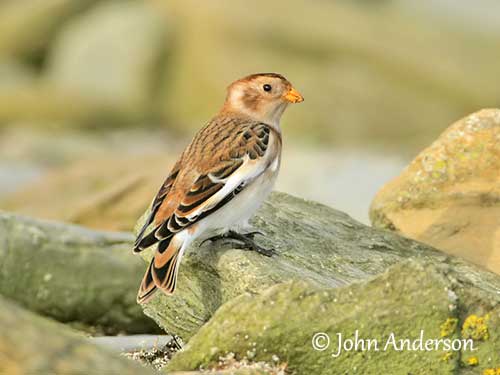
BEHAVIOUR IN THE WILD:
The Snow Bunting usually feeds on seeds, buds and insects, and some other invertebrates such as small crustaceans in coastal habitats. During the breeding season, the chicks are fed on arthropods including insects and spiders.
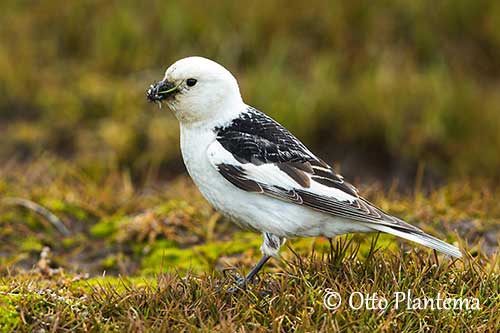
The Snow Bunting forages on the ground or in low vegetation by walking, running and hopping. Flying insects are caught by sallies. It also burrows into the snow when searching for food.
During the non-breeding season, they form huge flocks of tens or hundreds of birds, but small groups can be seen too, as well as only 2-3 birds together. They enjoy bathing in the snow.
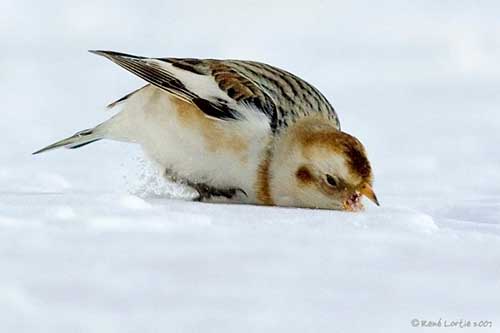
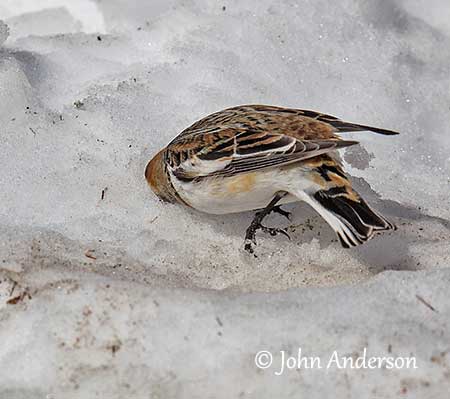
The pair forms between mid-May and early June, but depends on weather conditions. Males return to the breeding grounds 3-6 weeks before females, in order to claim and defend the territory. They often return to the same territory year after year.
Once females arrive, the male sings to attract them. When a female approaches, it pursues her. Flight displays are performed too. The male flies up high in the air before gliding down on V-shaped wings and while singing.
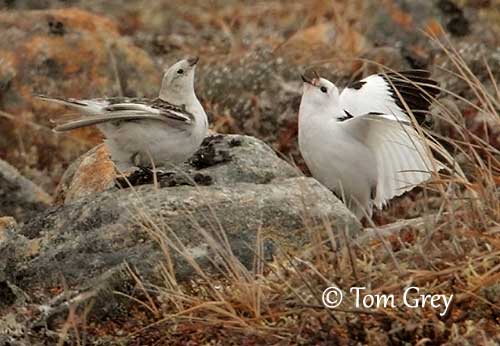
But the birds display on the ground too. The male circles the female by walking, while its wings are held up in a V prior to copulation. During this display, the strong black-and-white contrast of the male’s upperparts is enhanced by spreading wings and tail and turning the back to the female.
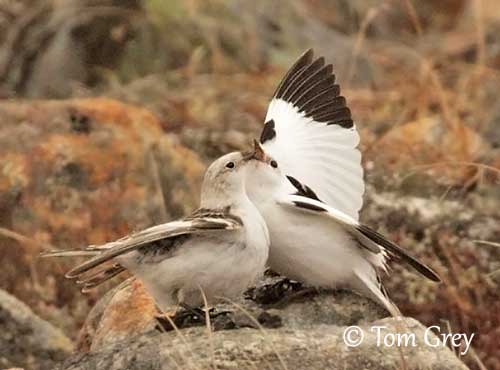
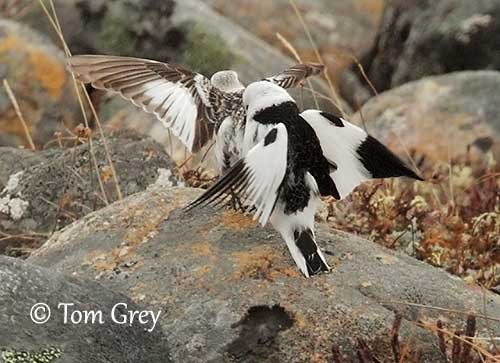
The male may also grab the tail or the back feathers of the female, and hangs on for 20-30 seconds.
They are monogamous, and competition between males is extreme.
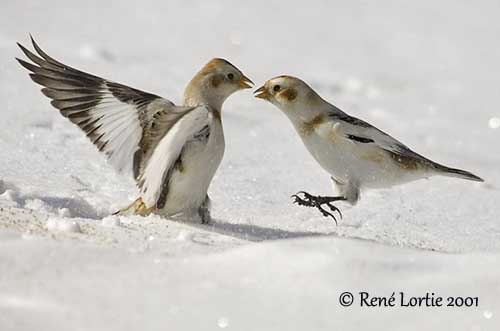
The Snow Bunting is migratory and usually females migrate farther S than males. They leave the breeding grounds between September and early November, depending on the wintering areas.
According to weather conditions, they arrive in low Arctic in mid-March, and mostly early April in high Arctic. They migrate in loose flocks.
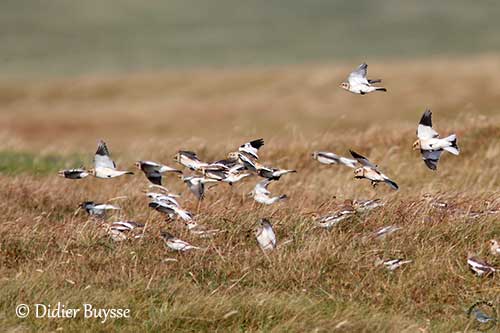
The Snow Bunting has swift flight with rapid wingbeats. During the migration, the large flocks seem to be in constant motion with birds from the back flying forwards over the birds in the front. There is a hierarchy in these flocks. Adult birds are dominant over 1st winter young, and males over females.
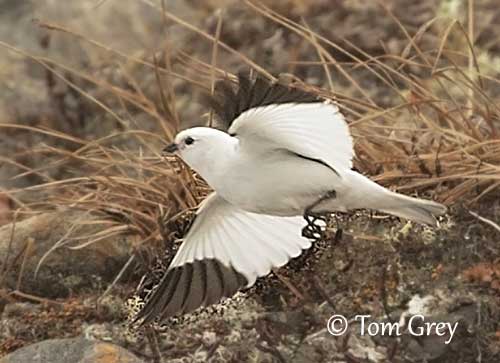
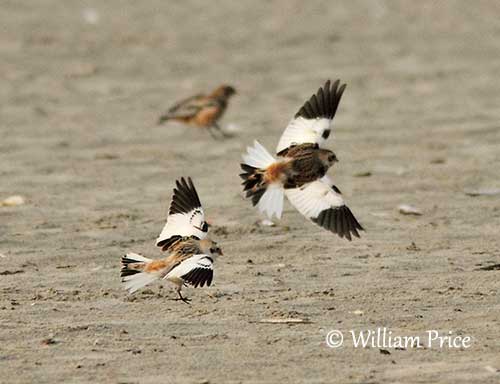
REPRODUCTION OF THIS SPECIES:
The breeding season occurs during summer, from late May to September. The egg laying depends on weather conditions and may occur significantly later in years with cold spring.
The nest is placed in a protected cavity such as deep rock crevice or hole in the ground. The female collects material and builds the nest, a thick cup-shaped structure made with grass and moss and lined with softer material such as finer grass, rootlets, plant down, feathers and fur.
The female lays 2-8 whitish to pale blue-green eggs with brown spots on the larger end. She incubates alone during 12-14 days, and she is often fed on nest by the male. In this way, the female spends more time on the eggs, and this is very important in the cold northern climate.
The chicks are fed on arthropods by both parents and fledge 10-17 days after hatching. This species produces a single brood per season.

PROTECTION / THREATS / STATUS:
The Snow Bunting has wide range in which it is common and even very common in suitable habitat, in spite of some decline during the last 30-40 years.
This species is preyed upon by the Arctic fox, gulls, skuas, Gyrfalcon and Snowy Owl. They try to avoid predators by hiding the nests among the rocks or in holes. The white plumage is also used as camouflage in the snowy habitat.
The global population is estimated to number more than 40,000,000 individuals. After some decline, this population has begun to recover, due to the reduction of grazing and no more embankment projects planned. These projects have involved the destruction of saltmarshes in coastal areas in S North Sea.
The Snow Bunting is currently evaluated as Least Concern.
